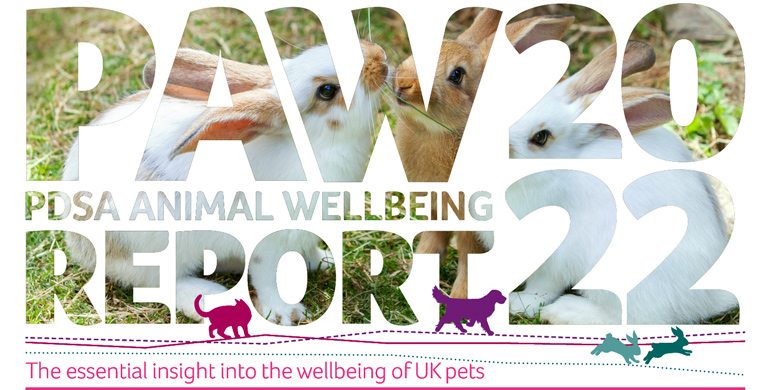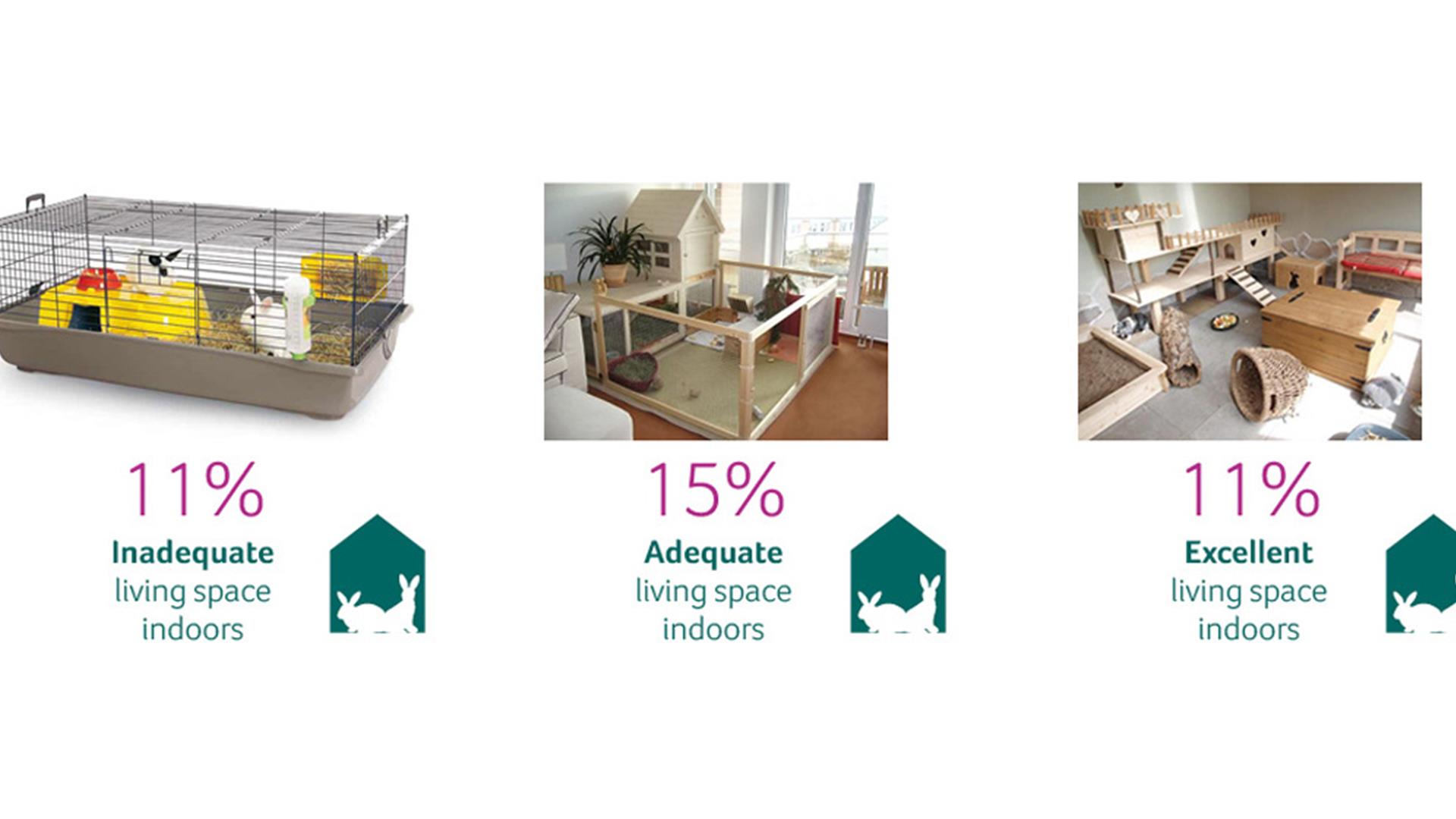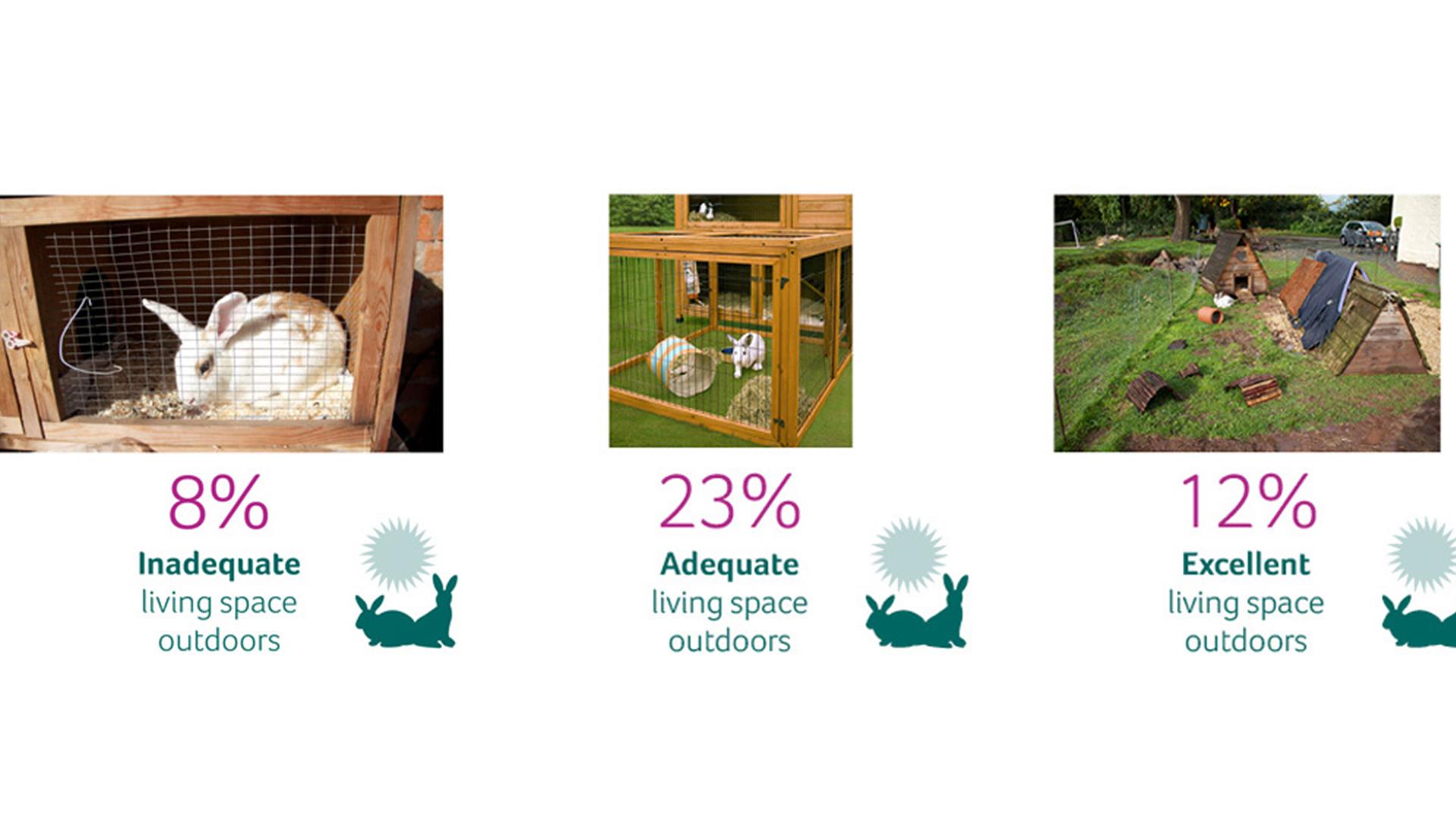Environment
As one of the 5 Welfare Needs, owners have a legal obligation to provide a suitable environment for their pet. This includes the right type of housing with a comfortable place to rest and hide as well as space and opportunity to exercise and explore. 95% of owners told us that they felt informed about how to provide for their pet’s environmental needs.
Dogs
Walking is not just important for the physical health of our dogs, but essential for their mental wellbeing as well. Using their senses when out of the home environment, especially sniffing and scent marking, has been shown to be important to dogs11, so being given the opportunity for enrichment while on walks enhances their welfare as well as providing for the opportunity of social interactions. However, walks may not be suitable for every dog as some may struggle to cope with the external environment, so need alternatives to engage the senses and meet their needs.
Enrichment opportunities on dog walks
75% of dog owners told us that their dog has unrestricted sniffing and exploration opportunities on their walk, while 69% have interaction with other dogs and 64% have off-lead or long-lead exercise which give them freedom to run and explore, unrestricted by the constraints of a short lead. 6% of dog owners, 610,000 dogs, said that their dog had none of the enrichment opportunities* on a walk.
Owners who said their dog was not currently registered with a vet were more likely to also say that their dog had none of these enrichment opportunities on a walk (21%) compared to those who are registered with a vet (4%). Similarly, those who live in an urban environment (7%) were more likely to say that their dog had none of these enrichment opportunities compared to those in rural locations (3%). Younger owners (10% aged 18-24) were also more likely to say the same (4%) compared to those aged 55-64 (4%) or aged 65 or older (4%).
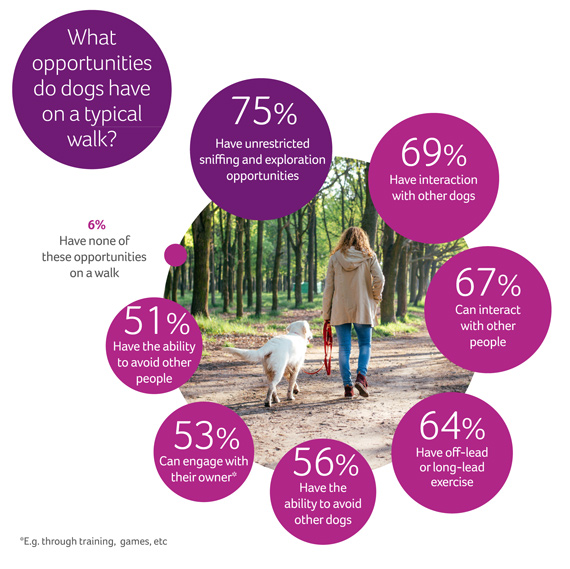
Owners concerns about dog walks
45% of owners told us that they have concerns about dog walking. The most common concerns reported were that they were afraid of their dog being attacked by another dog (17%), and that their dog doesn’t come back when called (11%). More owners who acquired their dog from abroad said they were concerned about their dog’s behaviour on walks (21%), compared to those who acquired their dog from the UK (9%). Owners who agreed with the statement that ‘owning their dog is stressful’ were more likely to have concerns about their dog’s behaviour on a walk (21%) compared to those who disagreed with that statement (7%).
54% of owners said they had no concerns about dog walking – this figure has remained the same from February 2020, but is higher than when the question was previously asked in 2016 (48%) and 2018 (47%). Owners who acquired their dog from abroad were less likely to say they had no concerns about walking their dog, at 41%, compared to those who acquired from the UK (54%).
5% of owners said that their concerns about dog walking related to time restrictions. This is a lower proportion than in previous years - 13% of owners reported these concerns in 2018 and 10% in February 2020. However, a higher proportion of owners who have owned their dog since the start of the COVID-19 pandemic (7%) are concerned about time restrictions compared to those who have owned for 3-5 years (4%) or over 5 years (4%). This could reflect that in the last few months some of these owners may be experiencing a change away from home-based working for the first time since owning their dog, as workplaces reopen after the lockdowns of the pandemic.
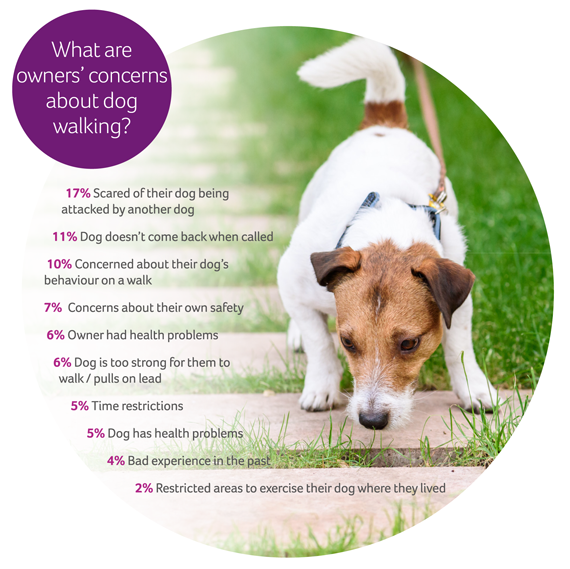
Cats
The majority of cats in the UK (70%) have access to both indoor and outdoor environments. 28% live indoors only which, while increased compared to earlier PAW Report surveys (15% in 2011), has not changed since 2017 (26%).
It is important for cats to have the opportunity to exercise in the home. 83% of owners told us that their cat exercises by running around the house, 67% play with toys and 23% have a cat climbing frame. 43% of owners encourage their cat to use the stairs by spreading out resources such as food and water bowls and beds, which can be a good technique to increase exercise, alongside being a preference for cats.
The opportunities for indoor exercise were higher for those cats that live indoors only (89% run around the house, 80% play with toys, 39% have a cat climbing frame) compared to those who live indoors and outdoors (81%, 62% and 17% respectively). This could reflect awareness amongst owners of indoor-only cats of the importance of offering exercise options for their pet.
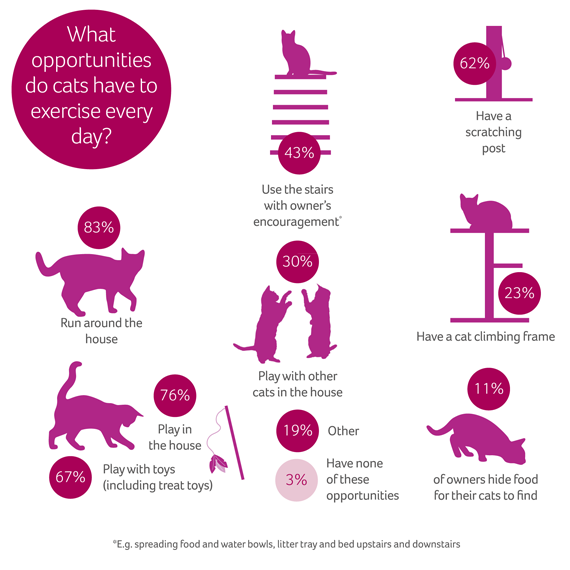
Rabbits
In 2022, 51% of rabbits live predominantly outdoors, and 49% indoors. Whether owners choose to house their rabbits inside or out, they need to be provided with adequate space to allow them to hop, run, jump, dig and stretch out fully. The recommended living area for two average sized rabbits is a single enclosed area of at least 3m x 2m by 1m high12.
When we asked owners to identify which image most closely resembled their pets’ living space, 19% of owners selected images of small hutches with little or no run space, meaning that 190,000 rabbits are living in inadequate housing conditions. 8% of rabbits living predominantly outdoors are in inadequate housing, and 11% of rabbits living predominantly indoors.
4% of rabbits can only hop 0-2 times across the widest part of their living quarters. While this is lower than when we previously asked in 2015 (7%), 39,000 rabbits still do not have adequate space for exercise. 44% of rabbits can do 3 or more hops – this is significantly higher for rabbits who live predominantly outdoors (59%) compared to inside (35%). It is possible for rabbits living indoors to have adequate housing, but it can be more difficult for owners to give them the space they need. 27% of rabbits have full run of the house, while 20% have the run of the garden – this may reflect the need to keep outdoor rabbits enclosed for safety from predators.
In an average 24 hours, 46% of rabbits spend 11-23 hours in a hutch, lower than in 2017 (63%) and 2018 (52%). 15% of rabbits spend 6-10 hours in a run in the garden (higher than in 2017 when it was 10%), and 19% spend 11-23 hours free roaming in the house (higher than in February 2020 when it was 11%). These figures may suggest that owners are recognising their rabbits’ need for exercise and space to roam, however, the mean number of hours rabbits spend in different environments over 24 hours is unchanged from February 2020. 21% of rabbits spend no time interacting with their owner in an average 24 hours.
Rabbits' living space
Travel abroad
In 2022, 6% of pet owners told us that they had travelled abroad with their pets. This is higher for dog owners (9%) than cat (3%) or rabbit owners (4%). The most common destinations are countries within the EU (6% of dog owners, 2% of cat owners and 3% of rabbit owners) with 68% of these owners travelling at least once a year. Of those owners that do travel abroad with their pet, 58% do so for a holiday, and 39% visit family abroad. 14% told us that they travel abroad with their pet to compete in pet shows or competitions.
Hear from Veterinary Specialist Advisor at the Rabbit Welfare Association & Fund (RWAF) Dr Richard Saunders, MRCVS
 Video found at youtu.be/aICIe5k7IVQ
Video found at youtu.be/aICIe5k7IVQ
Dr Richard Saunders BSc (Hons) BVSc MSB CBiol DZooMed (Mammalian) MRCVS, Veterinary Specialist Advisor, RWAF

Footnotes
* Unrestricted sniffing and exploration, engagement with the owner (e.g. training, games, other interaction), interaction with other dogs, ability to avoid other dogs, interaction with other people, ability to avoid other people, off-lead or long-lead exercise.
11. Řezáč, P., Viziová, P., Dobešová, M., Havlíček, Z., & Pospíšilová, D. (2011). Factors affecting dog–dog interactions on walks with their owners. Applied Animal Behaviour Science, 134(3-4), 170-176.
12. https://rabbitwelfare.co.uk/space-recommendations/

